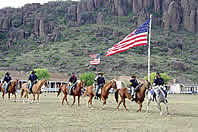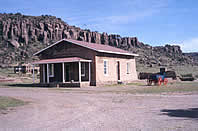 |
||
 |
||
FORT DAVIS NATIONAL HISTORIC SITE |
PHOTOGRAPHS: |
|
TEXAS Sounds of the bugle echo off the mountain! Palisades of vertical volcanic cliffs stand like sentinels guarding the post…and the past. Hear the clatter of horses' hooves, officers shouting orders, soldiers marching in step, and the firing of the evening gun-boom! Hear "The Star Spangled Banner" played like you have never heard before-an old version dating to the 19th century. Suddenly your imagination takes you back to 1875, when the garrison was staffed by Buffalo Soldiers. In the silence, one's spine tingles in an eerie way. You stand amidst the ghostly ruins of this remote frontier army garrison. Except for the spirits of thousands of men, women and children who lived and sometimes died at this remote and lonely fort, only the sapphire sky and the immortal west Texas wind are there to keep you company. Their spirits endure today and give the ruins a voice. If you listen, the ruins tell their story…and without realizing it, you connect to the past. A key post in the defense system of west Texas, Fort Davis played a major role in the history of the Southwest. From 1854 until 1891, troops stationed at the post protected emigrants, freighters, mail coaches, and travelers on the San Antonio-El Paso Road. Today, Fort Davis, located in the heart of the Davis Mountains, is considered one of the best remaining examples of a post-Civil War frontier military post in the American Southwest because of the extent of the surviving structures and ruins. It is a vivid reminder of the significant role played by the military in the settlement and development of the western frontier. Named for Secretary of War Jefferson Davis, the fort was first garrisoned by Lieutenant Colonel Washington Seawell and six companies of the Eighth U.S. Infantry. The post was located in a box canyon near Limpia Creek on the eastern side of the Davis Mountains - where wood, water, and grass were plentiful. From 1854 to 1861, troops of the Eighth Infantry spent much of their time in the field pursuing Comanches, Kiowas, and Apaches who terrorized travelers and attacked mail stations. With the outbreak of the Civil War and Texas's secession from the Union, the federal government evacuated Fort Davis. The fort was occupied by Confederate troops from the spring of 1861 until the summer of 1862, when Union forces again took possession. They quickly abandoned the post and Fort Davis lay deserted for the next five years. Fort Davis is important in understanding the presence of African Americans in the West and in the frontier military because four all-black regiments established after the Civil War, the 24th and 25th U.S. Infantry and the 9th and 10th U.S. Cavalry, were stationed at the post. It was troopers of these two cavalry regiments that earned the nickname "Buffalo Soldiers" - a term supposedly given them by the Indians because of the resemblance of their hair to the short, curly hair of the buffalo. Fort Davis National Historic Site was added to the National Park System in 1961. DID YOU KNOW
DON'T MISS ATTRACTIONS
NATIONAL PARK SERVICE PRIORITIES
|
Click a photo to view larger version. LINKS: Fort Davis National Historic Site» Partnering & Managing for Excellence Report»
|
|







